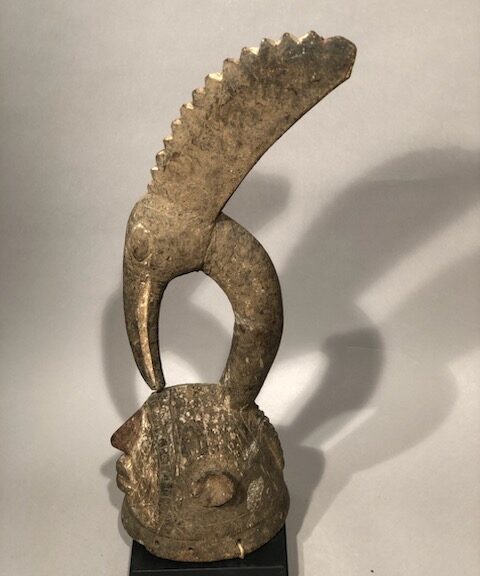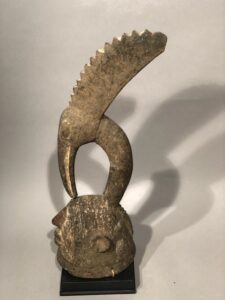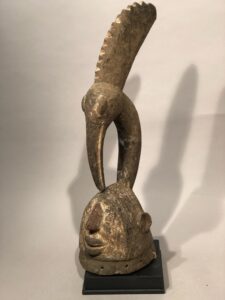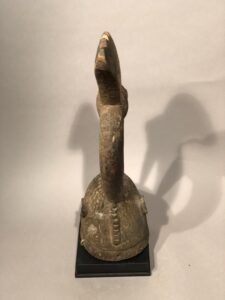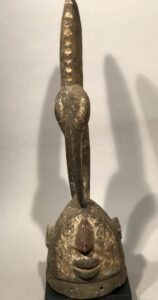LSK 1121-4
Bobo Helmet Mask, Burkina Faso
This type of helmet mask, known as ‘Bolo’ (pl. bole), is worn by blacksmiths at important agricultural festivals, initiation rituals and funerals in Bobo communities. In performances, bole functions primarily as entertainment, while other older mask types are considered more sacred and have greater spiritual weight. Bole can take two different forms; the full helmet type is seen here. The facial features of this example are crudely carved but accentuated by a number of exquisite details. The surface of the mask is incised with numerous vertical and diagonal lines creating intricate geometric patterns of squares. The incised patterns have in their time been brightly colored with red, white and blue/black pigments. An elaborate fiber costume has been attached to the holes at the bottom of the mask to cover the performer, who is invariably a male dancer. Bole most often represent human subjects, thus the anthropomorphic appearance of this mask; however, there are other types of bol representing different animals, including the antelope, the ram, the monkey, and the rooster. In this case, a bird.
During Bobo masquerades, wooden masks like this one spin wildly, seemingly out of control, from one side of the open dance arena to the other. The performance climaxes in a tour-de-force rotation of the mask. The wooden mask is raised above the artist’s head and rapidly rotated through two or three revolutions. It is common to see the identity of the blacksmith artist during such maneuvers.
Although today both farmers and blacksmiths use wooden masks, only the blacksmiths make the masks. Blacksmiths maintain a unique position in Bobo society; they are considered supernatural men who possess associations with invisible spirits and mystical powers inaccessible to ordinary citizens. Due to their intermediate position between the earthly and spiritual realms, only blacksmiths possess the secret knowledge and strength to create a wooden mask and channel its powerful powers.
The original inspiration for the bolo masking tradition came from the nearby Zara people, but the Bobos have since transformed it to such an extent that only the name remains as an indicator of its Zara origins. The open spaces of western Sudan have facilitated a history of cultural exchange between the region’s ethnically diverse inhabitants. In the fifteenth and sixteenth centuries, a Mossi kingdom was formed, bringing together numerous ethnic groups such as the Bobo, Bwa, Gurunsi, Kurumba and Lobi and resulting in a network of mutual influence and assimilation in the area. As a result of this historical context, many similarities can be seen in regional artistic forms and cultural practices.
Age: Late 20th Century
Measure: H: 55, W: 17, L: 19 cm.
Condition: Wood, aging patina pigment. Despite visible age in good condition and without insect attacks and damage.
Provenience: Erhvervet fra dansk/italienske arvingerne til en Italiensk familiemedlems samling.
Literature: Baquart, Jean-Baptiste. The Tribal Arts of Africa. New York: Thames and Hudson Inc. 1998.
Request price for Bobo, Burkino Faso